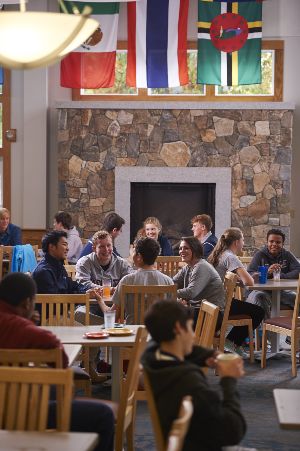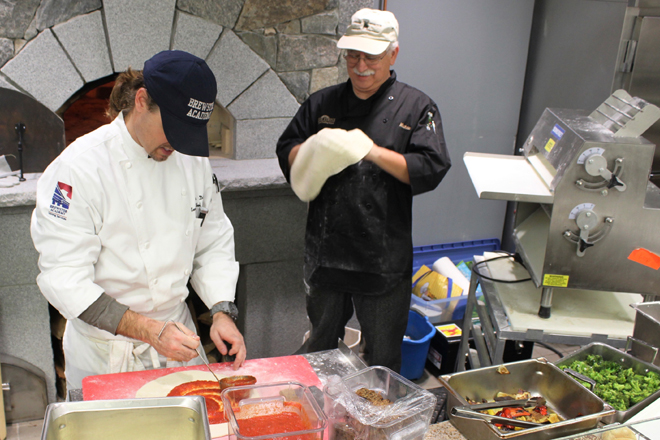Article by Leah Thayer
Meals at most independent schools have come a long way since the mystery meat and glutinous mac-and-cheese of yore. Today you’ll find locally grown and organic, vegetarian and vegan, gluten-free and nut-free, sustainable seafood and grass-fed beef. You’ll find scratch-cooking and culinary clubs, pizza carts and smoothie stations, and bars for salads, soups sandwiches. What you won’t find, at least as far as Charlie Parrish’s investigations have revealed, is a how-to guide for running a food service program that is not only popular and nutritious — that part is easy, given all of today’s options — but also profitable for the independent schools that offer them.
“We’re trying to put food on the front burner,” punned Parrish, financial officer at First Presbyterian Day School, in Macon, Georgia, whose 920 students range from preK through 12th grade. About 15 years ago, the school launched an optional lunch program with a respected third-party dining vendor. The program’s financial goal is for dining revenues to cover its non-facility costs including labor, food, supplies and management fees. “We have accomplished that since inception,” he said. The challenge? Despite consistently high ratings from students who participate in the lunch program, their numbers have declined, and “we’re close to a tipping point” at which the program’s revenues cover those costs. Lunch participation is now hovering at around 59 percent, down from a high of 75 percent.

Parrish is still evaluating what’s behind the downturn at FPDS, perhaps some combination of students’ particular tastes and families’ sensitive budgets (lunch costs from $4.50 to $6 per day, depending on grade, adding about $1,000 a year to tuition). He’s proud of the meal program and hopeful about efforts to publicize it. But absent resurgent student participation, “we’re going to need to make some changes to either the revenue or expense side that will help us sustain our budget goals,” he said.
FPDS isn’t alone in facing this crossroads. While food service constitutes a relatively small portion of most schools’ operating budgets, its influence can loom disproportionately large in an increasingly competitive marketplace. “Oh, food is a big deal,” said Lisa Braiterman, chief financial and operations officer at Brewster Academy, a boarding and day school in Wolfeboro, New Hampshire. “This is a home for our kids,” she said of the school’s dining operation, an assertion borne out in her decision to give it a top-to-bottom remodel as her first project at the school “Think about it. More than 300 [boarders] come here every September, and other than breaks and occasionally going out to eat, they’re here three meals a day. Whenever they want to get together, it’s around food. Having a place that’s comfortable, where they have good, fresh, well-prepared food — it’s very important.”
Getting dining services right is very important for schools too, day and boarding alike, regardless of whether they outsource it or manage it in-house. “The pressure is on to keep it fresh and interesting and well-managed,” said Valerie Scruggs, the in-house food service director at University School in Shaker Heights, Ohio, whose 15 food service staff produce some 1,300 lunches each day. Here are some ways schools like hers continually adjust their menus, staffing, costs and more to uncover new strategies for operating dining programs that support students’ quality of life as well as the schools’ bottom lines.
Competing Demands
More dietary demands, more dietary restrictions, more cost pressures all around: Squeezed by competing demands, growing numbers of independent schools have opted to outsource their dining options to third-party vendors whose culinary expertise, corporate structures and economies of scale let them offer more choices, for predictable costs, than most schools can offer. Well-known national contractors include SAGE Dining Services (nearly 250 independent school clients) and Flik Independent School Dining. Many business officers cite the variety and high quality of food these companies can provide, in addition to relieving schools of responsibilities such as inventory and personnel management.
There really is no mystery [to running a food service program]. The key is making sure your dining program has leadership with a vision consistent with what you want to do who have the right experience and background.
Lisa Braiterman
Brewster Academy
Others feel differently. At BA, Braiterman brought dining services in-house in 2011, after decades with a contractor. She also remodeled the dining room and serving area. “It’s been a great move,” she said. Costs have gone down though wages went up. Quality has risen too, evidenced by higher consumption and positive feedback. “Some business officers are afraid of running a food service program. They are not sure they can understand it or know how to recruit and supervise the right people. There really is no mystery,” she said. “The key is making sure your dining program has leadership with a vision consistent with what you want to do who have the right experience and background. It's the same as leadership in any other department. In fact, it's easier since we all know when food tastes good or bad. But we don't all know something is constructed well or poorly.”
The leader at BA is its executive chef-manager, Chris Dill, a Culinary Institute of chef who leads a full-time team of 24 ranging from executive sous chef (who also serves as buyer) to dishwashers. All work essentially year-round. Good pay and benefits, predictable hours and abundant advancement opportunities keep turnover low and are a core factor in lower overall costs, Braiterman said.
Other strategies schools may wish to consider:
- Slow it down. “The chaos of lunch can be a challenge,” said Parrish of the typical 30 minutes or so many students have to get through the food line, find a seat and eat. He’s noticed that high school students at FPDS say they love the actual food but often opt to bring something from home to eat outside of the “Grand Central Station environment” of the dining hall.
BA tackled these challenges directly with its 2011 remodel. The “servery” went from having just one hot-food line to two, along with a central soup bar, two sandwich bars, two salad bars and a panini press to keep students moving. Making this area separate from the dining hall helps to maintain a quiet space for savoring flavors and conversation, as does the carpet-style flooring (resistant to mold, mildew staining) that replaced the noise-bouncing vinyl floors.
- Do more with less. Every casual chef knows last night’s leftover chicken can be tonight’s chicken soup. “Whatever they don’t eat, if it’s not served, it might show up again in the buffet or soup,” said University School’s Scruggs. She takes pride in the school’s all-scratch cooking, scoops up large quantities of local seasonal produce that can be served many ways, and manages to keep meal costs below $3, on average, even with entrees like salmon and mussels where possible. She also welcomes nice days for low-cost picnics.
- Target athletes. Athletics can be a major selling point for independent schools, but feeding athletes just about carb-loading the night before the big event. “Boys read all these muscle magazines and all they can think about is protein,” said Kathleen Searles, a board-certified sports nutritionist who works with independent schools. “They think if they eat three pork chops and four chicken legs, they’ll set the world on fire.” Commercially marketed sports bars and drinks, in turn, are often loaded with artificial sweeteners, dyes preservatives.
In a focused effort to help schools attract, retain and feed student-athletes. SAGE is rolling out a nutrition education program called Performance Spotlight. It includes all-natural sports drinks and sports bars, along with an athletic catering guide to help coaches and athletic directors get athletes the optimum kinds and quantities of food at the right times, from team meals 8 to 10 hours before a competition to post-performance recovery snacks an hour afterward. Early testing of the program has gone well, according to Lesley Vogel, SAGE’s nutrition director. “This generation of students, especially student-athletes, are really interested in the connection between what they put into their body and how they perform.” This fall the company will begin labeling “performance picks” in menus and dining lines.
- Engage students. Some third-party dining contractors use color-coding and other visual cues to inform students about dishes’ nutritional value and potential allergens. For more direct engagement, invite student input directly. BA’s student dining committee meets monthly with the dining services manager; students are also encouraged to post feedback and requests on a “napkin board.” The student dining committee at FPDS includes a student representative from every grade from 5th grade on up. “They’ve really taken on some ownership of the menu,” Parrish said. “It’s been wonderful in allowing us to engage in an open and honest dialog, gain a better understanding of student preferences and help students understand the issues involved with sustaining a lunch program.”
At University School, Scruggs runs a “culinary club,” among other strategies to engage students. She strives “to make them feel welcome. They have a voice.”
- Promote to parents and prospects. “We believe that our lunch program is one of the assets that can ultimately attract and retain students,” said Parrish. Visiting students at FPDS are encouraged to have lunch — and giving “over-the-top” reviews, he said. “It’s on our website, we’ve got a video and we talk about it more often.” The school also holds “dining days” to encourage parents of existing students (especially younger children) to experience the lunch option for themselves.
- Focus on emotional well-being. Project Thrive is a new program from Pedestal Foods, a dining services contractor that works with schools in the Southeastern U.S. Developed in conjunction with the Anxiety and Depression Association of America, the initiative sets out to combat anxiety and depression in students by encouraging gratitude, optimism, humor and kindness alongside healthy food choices, and then rewarding students for good choices.
- Leverage technology. SAGE last year launched the “Touch of SAGE” app to interface with each school’s menus and ingredient lists. Parents and students alike can use it to discuss choices, identify favorites, provide chef feedback and more. FLIK offers a similar service through its mySchool Dining website and related app.
- Partner with a local school district. This can be especially cost-effective for small schools with optional lunch programs. “It’s been wonderful for us,” said Reba Stephens, finance director at Marist Catholic High School in Eugene, Oregon. “Due to [the local district's] bulk purchasing and centralized management, they are able to offer good lunches at an affordable price. We collect the proceeds daily and remit them to the school district on a monthly basis.” Students pay $4.50 for a hot lunch that includes all-you-can-eat salad bar.
A similar program operates in Omaha, Nebraska, where 22 private K-8 schools use the Westside Community Schools district as their outsourced contract meal provider, according to Food Management. With three daily lunch choices, teachers collect some 4,200 orders each morning from students and load them onto Google Docs. The district’s central kitchen produces the requisite amount of each menu item and delivers the contract lunches via five trucks.



